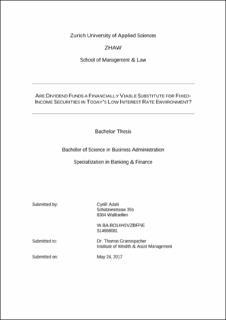Please use this identifier to cite or link to this item:
https://doi.org/10.21256/zhaw-1323| Publication type: | Bachelor thesis |
| Title: | Are divided funds a financially viable substitute for fixed-income securities in today's low interest rate environment? |
| Authors: | Adali, Cyrill |
| Advisors / Reviewers: | Gramespacher, Thomas |
| DOI: | 10.21256/zhaw-1323 |
| Extent: | 56 |
| Issue Date: | 2017 |
| Publisher / Ed. Institution: | ZHAW Zürcher Hochschule für Angewandte Wissenschaften |
| Language: | English |
| Subject (DDC): | 332.6: Investment |
| Abstract: | Over the last centuries, interest rates in most of the developed economies have continuously decreased. Since bond yields are heavily linked to central interest rates, income-oriented investors have experienced a decline in annual cash flows from bond investments. Some experts advise to invest in high dividend yielding stocks or funds consisting of such stocks to achieve higher annual payouts than the bond market. However, annual payouts can only be compared if investments are adjusted for risk. The aim of this analysis was to test if dividend funds can in fact be used as a financially viable substitute for traditional fixed-income securities in times of low interest rates by testing if dividend funds have managed to achieve similar or higher annual cash payouts without exceeding the risk/reward relationship of bond investments. An analysis of the market of dividend funds in Switzerland and the United States was conducted to provide an overview of the characteristics of products in both markets. As a second step, the cash flows from dividend distributions were compared to coupon payments of a bond benchmark. The third part of this paper evaluated the historic returns of both asset classes using time series of monthly prices obtained from Bloomberg. The risk-adjusted performance of the securities was assessed by their Sharpe ratio, which enables comparing the performance of investments across different asset classes. Furthermore, investments were tested for abnormal returns according to the Capital Asset Pricing Model (CAPM). Additionally, the amount of abnormal returns was statistically tested for its significance by running a two-sided hypothesis test to prove if the achieved abnormal returns are statistically substantial. The yield comparison illustrated that Swiss dividend funds have generated higher yields than the bond market. US Dividend funds yielded in average 0.27% less than the bond market. Given this small deviation, US dividend yields were described as comparable to bond yields. Funds in both market displayed a better Sharpe ratio than bond markets in recent years, but failed to produce superior Sharpe ratios over time horizons exceeding 5 years. The examined Swiss dividend fund has produced substantial negative abnormal returns over the last 10 years, while US dividend funds have generated significant abnormal returns over all applied time horizons. Overall, Swiss dividend funds are suited to generate annual income, but the findings suggest that their risk/return profile is inferior to the bond market. US dividend funds generated comparable yields as the bond market and displayed better risk-adjusted performance. Based on historic data, US dividend funds can be used as a substitute to bond investments in normal market situations. However, rising interest rates in the US are likely to increase bond yields, which would suggest that dividend funds would be unable to generate comparable annual income in the future. Since Swiss interest rates are more likely to stay low, dividend funds remain attractive for income investors who can bear the higher risk exposure. |
| URI: | https://digitalcollection.zhaw.ch/handle/11475/1360 |
| License (according to publishing contract): | CC BY 4.0: Attribution 4.0 International |
| Departement: | School of Management and Law |
| Appears in collections: | BSc Betriebsökonomie |
Files in This Item:
| File | Description | Size | Format | |
|---|---|---|---|---|
| Adali_Cyrill_W.BA.BO.BF.pdf | 2.69 MB | Adobe PDF |  View/Open |
Show full item record
Adali, C. (2017). Are divided funds a financially viable substitute for fixed-income securities in today’s low interest rate environment? [Bachelor’s thesis, ZHAW Zürcher Hochschule für Angewandte Wissenschaften]. https://doi.org/10.21256/zhaw-1323
Adali, C. (2017) Are divided funds a financially viable substitute for fixed-income securities in today’s low interest rate environment? Bachelor’s thesis. ZHAW Zürcher Hochschule für Angewandte Wissenschaften. Available at: https://doi.org/10.21256/zhaw-1323.
C. Adali, “Are divided funds a financially viable substitute for fixed-income securities in today’s low interest rate environment?,” Bachelor’s thesis, ZHAW Zürcher Hochschule für Angewandte Wissenschaften, 2017. doi: 10.21256/zhaw-1323.
ADALI, Cyrill, 2017. Are divided funds a financially viable substitute for fixed-income securities in today’s low interest rate environment? Bachelor’s thesis. ZHAW Zürcher Hochschule für Angewandte Wissenschaften
Adali, Cyrill. 2017. “Are Divided Funds a Financially Viable Substitute for Fixed-Income Securities in Today’s Low Interest Rate Environment?” Bachelor’s thesis, ZHAW Zürcher Hochschule für Angewandte Wissenschaften. https://doi.org/10.21256/zhaw-1323.
Adali, Cyrill. Are Divided Funds a Financially Viable Substitute for Fixed-Income Securities in Today’s Low Interest Rate Environment? ZHAW Zürcher Hochschule für Angewandte Wissenschaften, 2017, https://doi.org/10.21256/zhaw-1323.
Items in DSpace are protected by copyright, with all rights reserved, unless otherwise indicated.